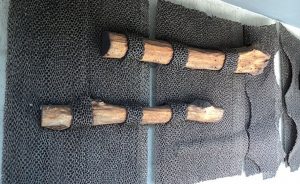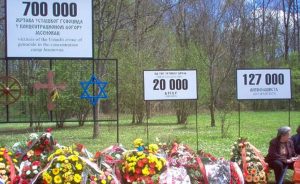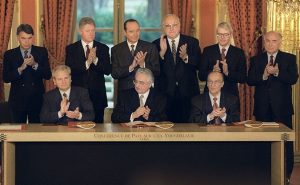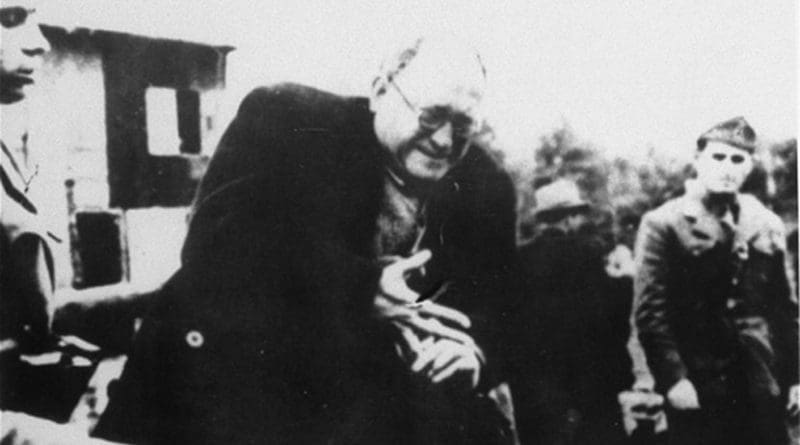Croatia’s Jasenovac Death Toll: A Political Numbers Game – Analysis
Politically-motivated Serbian exaggerations and Croatian underestimates of the number of victims at the WWII Croatian fascist concentration camp at Jasenovac do not hold up to scientific scrutiny, research shows.
By Sven Milekic
In the latest spat between Zagreb and Belgrade over the WWII concentration camp at Jasenovac – run by the Croatian fascist Ustasa movement – the death toll at the camp has again been called into question.
For decades, politicians, academics and others in Croatia and Serbia have argued about the number of people who died at the camp – offering figures ranging from as low as 1,500 victims to as high as 1.1 million.
But despite the various differing claims from sources in Croatia and Serbia, there are verified facts, backed up by respected institutions and experts, which give a reliable estimate of the number of the people killed at the camp.
The most recent row saw Croatia protest about an exhibition on Jasenovac that was organised by Serbia at the UN building in New York last Thursday, claiming it was misused for political purposes – to identify Croatia with fascism and tarnish its international image.
Serbian Foreign Minister Ivica Dacic rejected these claims, asking Croatian Prime Minister Andrej Plenkovic to say which ethnic group formed the greatest number of Jasenovac victims and what the exact death toll was.
“Just as Plenkovic goes to Yad Vashem [Holocaust memorial centre in Jerusalem], we expect him to do the same in Croatia and Jasenovac itself and to clearly define and say who the victims are. Were there 50,000, 100,000 or 700,000 [deaths]?” Dacic said on Friday.
Dacic was intimating that Croatian politicians try to downplay the crimes committed at the camp and the death toll. So far, Plenkovic has not responded.
Croatian political analyst Zarko Puhovski suggested the continuing dispute between the two countries about Jasenovac has its roots in the 1990s war.
“Croatia had a position in which it tried to downplay Jasenovac… while Serbia acted as if only Serbs were killed there,” Puhovski said.
Vision of an ethnically pure state
The Ustasa-led Nazi puppet state, the Independent State of Croatia – which included most of present-day Croatia, all Bosnia and Herzegovina and a small part of Serbia – had a population of some six million people, incluing around 3.5 million Croats, 1.8 million Serbs and 700,000 Bosniaks.
In its vision of an ethnically pure state – with Bosniaks considered as Croats of the Muslim faith – the NDH started targeting Serbs and two minorities, Jews and Roma, after it was founded in 1941.
Modelled on Nazi Nuremberg laws, the NDH in April 1941 passed legislation against “non-Aryan” Jews and Roma.
Serbs, who were referred to as “Greek-Easterners” in Ustasa legal documents, were not directly labelled as a “non-Aryan” people, but were persecuted indirectly through other legislation against enemies of the NDH.
The general idea, as expressed by some prominent Ustasa officials, was to kill a third of the Serbs, deport a third and convert the other third from Orthodox Christianity to Catholicism. Around 100,000 Serbs were converted to Catholicism.
Jasenovac, which opened in late August 1941 and operated until late April 1945, was the biggest concentration camp in the Ustasa camp system.
Jasenovac itself was composed of five sub-camps, one of which was Stara Gradiska, an Austro-Hungarian fort used as a prison by many regimes throughout the 19th and 20th centuries.
Listing the victims, one by one

In the 2000s, the Jasenovac Memorial Site started working on a list of all the inmates who were killed or died at the camp, using existing name-by-name lists, documents, confirmations of deaths and verifications by relatives.
The Memorial site has put together the most comprehensive name-by-name list so far, which includes a total of 83,145 victims.
Sorted by ethnicity, the list has 47,627 Serbs, 16,173 Roma and 13,116 Jews, while Croats, Bosniaks and others make up the total number. Those who were not Serbs, Roma or Jews were killed because they were anti-fascists, as well as real or suspected political enemies.
From the total number, 39,570 were adult men, 23,474 were adult women, while 20,101 were children.
While the Memorial Site itself says that the number is not final, as well as admitting the possibility that there are isolated mistakes in its list, it believes that the total death toll is within its estimate of between 80,000 and 100,000 people.
These figures fall inside a range of other estimates made by the Belgrade Museum of Genocide Victims (80,022), the United States Holocaust Memorial Museum (between 77,000 and 99,000) and the Simon Wiesenthal Centre (85,000). The latter two institutions do not offer name-by-name lists.
Regarding the number of Jewish victims at Jasenovac, Yad Vashem offers a longer name-by-name list, with 16,196 victims.
Croatian historian Ivo Goldstein wrote in his book Holocaust in Zagreb in 2001 meanwhile that the total number of Jewish victims is probably close to 17,000.
Recently-deceased writer Slavko Goldstein explained in his book Jasenovac: Tragedy, Mythology, Truth that the difference spurs from Yad Vashem including Jews that were baptised into Catholicism – and therefore potentially classifiable as non-Jews – as well as Jews who were refugees from Nazi Germany, and who were not researched extensively.
Numbers game: the inflated Serbian figures

Some Serbian historians offered much larger numbers for the estimated death toll at Jasenovac. While writing the biography of Yugoslav President Josip Broz Tito in 1984, one Serbian historian, Vladimir Dedijer, put the number of victims at 700,000.
Bosnian sociologist and historian Radomir Bulatovic has even suggested a death toll of as many as 1.1 million people.
By comparison, some 1.1 million died at Auschwitz, the biggest Nazi death camp – but Jasenovac never had a mechanised extermination system like Auschwitz’s gas chambers, and its inmates were mostly killed by being shot or beaten to death.
Despite this, Serb sources have continued to offer much higher estimates than the Jasenovac Memorial Site.
In 2011, the International Commission for Establishing the Truth About Jasenovac, an NGO based in Bosnia’s Serb-dominated Republika Srpska entity, suggested a figure of over 800,000.
The Donja Gradina Memorial Site in Bosnia, also in Republika Srpska suggested 700,000.
In 1946, the first Yugoslav commission that listed the crimes of the Axis powers and their domestic collaborators estimated that between 500,000 and 600,000 people died in Jasenovac.
The 1960 edition of the Encyclopaedia of Yugoslavia offered the figure of 700,000 people.
However, none of these estimates is based on a name-by-name lists.
Croatian demographer Vladimir Zerjavic estimated the overall death toll in Yugoslavia during WWII as little over one million people.
Using demographic methods, statistics and documents, Zerjavic put the number of victims of Jasenovac between 80,000 and 90,000 people.
Bosnian statistician Bogoljub Kocovic came to a similar death toll as Zerjavic for the whole of Yugoslavia.
In his 1992 book Obsessions and Megalomania over Jasenovac and Bleiburg, Zerjavic explained that the overinflated numbers come from the death toll Yugoslavia reported to the Paris-based international commission for reparations – 1.7 million people – in 1946. This figure was later used as a basis for German reparations to Yugoslavia.
In his academic article On the Number of Victims of the Jasenovac Camp Complex, Ivo Goldstein also claims the same.
Numbers game: the understated Croatian figures

On the Croatian side, there were claims that the death toll is significantly lower than the 83,145 named by the Memorial Site.
In his well-known book Horrors of War: Historical Reality and Philosophy, published in 1989, Croatian 1990s President Franjo Tudjman, who was a historian, suggested that it was between 30,000 and 40,000.
In 1992, during the war, the Croatian parliament formed a commission to investigate all the crimes committed during WWII and the Yugoslav period.
In its report in 1999, the commission established a total death toll of 2,238 people for Jasenovac. Parliament was unsatisfied with the work of the commission and sent the report back for amendment – which was never carried out.
The most recent such estimate came from a Zagreb-based NGO, the Society for Research of the Threefold Jasenovac Camp, which claimed that the Yugoslav Communists established two post-WWII concentration camps on the site of the former Ustasa camp – a claim which is not supported by the vast majority of historical documents and history researchers.
The NGO, which does not have many professional historians, downplays the total WWII death toll, setting it at around 1,500, and saying that the majority died from diseases and maltreatment, not as a result of executions. It received around 5,600 euros for research archive documents from Jasenovac from the Croatian War Veterans’ Ministry in 2017.
The NGO’s profile was raised when controversial film director Jakov Sedlar released a documentary called Jasenovac – The Truth about its work in 2016. It was praised by Croatia’s culture minister at the time, Zlatko Hasanbegovic, but criticised for factual mistakes and for using unreliable documents.
None of the estimates from Croatia, except the one made by the Jasenovac Memorial Site itself, used scientific methods or took all historical sources into consideration.

